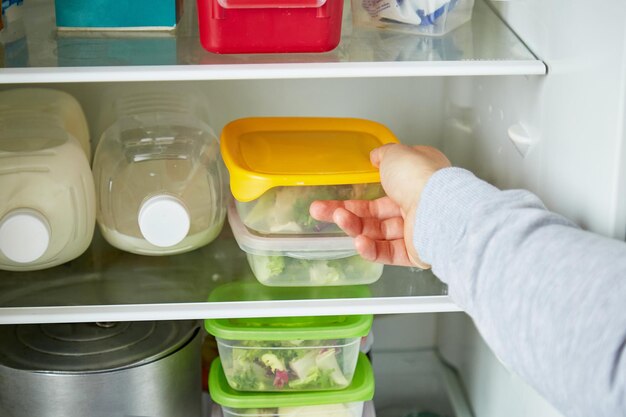Understanding the Shelf Life of Mayonnaise: Refrigeration Insights
Refrigerator doors open and close multiple times a day, and among the staple items that often sit inside is the trusty jar of mayonnaise. Whether it's a freshly purchased container or an almost-empty jar pushed to the back, understanding how long mayonnaise lasts in the fridge can help ensure your sandwiches and salads are both delicious and safe. Let's dive into the nuances of mayonnaise storage, its shelf life, and how best to prolong its freshness.
🥪 The Basics of Mayonnaise Shelf Life
The Science Behind Mayonnaise
Mayonnaise is a creamy dressing made from oil, egg yolk, vinegar or lemon juice, and seasonings. These ingredients, when emulsified, create a stable product. However, it's the egg yolk, a perishable ingredient, that often raises questions about how long mayonnaise can last once opened. The acid from vinegar or lemon juice acts as a natural preservative, but understanding storage conditions is key.
How Long Does Mayonnaise Last Unrefrigerated?
Commercially produced mayonnaise, often with added preservatives, boasts a longer shelf life than its homemade counterpart. On supermarket shelves, it can last for months without refrigeration. Once opened, it's crucial to store it properly to extend its usability. Generally, leaving mayonnaise out of the fridge for a prolonged period is not recommended, as it can spoil faster.
Expiration vs. Best-by Dates
Expiration dates refer to the safety of the product post-date, whereas best-by dates suggest when the product is expected to maintain peak quality. While mayonnaise can last beyond the best-by date if unopened, once opened, it’s better to rely on sensory indicators like appearance, texture, and smell to gauge its usability.
🧊 Proper Storage in the Refrigerator
Ideal Storage Practices
Once the seal is broken, mayonnaise should be stored in the refrigerator door's main compartment, where temperatures remain more consistent. Avoid placing it on the fridge door, where temperature fluctuations can occur. Always ensure the lid is tightly sealed to keep the product fresh.
Signs of Spoilage ⚠️
Look out for the following indicators that your mayonnaise might be past its prime:
- Off smell: A sour or putrid odor signals spoilage.
- Color change: Darkening or spotting within the mayo is a warning sign.
- Texture differences: Separation or curdling are red flags.
- Mold: Immediately discard if you see any mold growth.
Tips to Extend Freshness
- Clean utensils: Always use clean, dry utensils to avoid introducing bacteria.
- Consistent refrigeration: Don’t let it sit out too long after use.
- Seal tightly: Ensure the lid is properly closed after each use.
- Avoid cross-contamination: Keep the mayo jar away from raw foods.
🥄 Homemade Mayonnaise: What You Need to Know
While homemade mayonnaise offers a fresh and customizable taste, its lack of preservatives makes it more sensitive to spoilage. When stored in the refrigerator, homemade mayo typically lasts only one week. Here's how to enjoy it safely:
- Use fresh ingredients: Start with the freshest ingredients possible to maximize longevity.
- Fresh batch: Make smaller batches to avoid waste.
- Storage container: Use a clean, airtight container to store it.
Health and Safety Considerations
While mayonnaise is generally safe to consume past its best-by date when refrigerated, caution is necessary for vulnerable individuals like young children, pregnant women, and the elderly due to the risk of bacterial infections such as Salmonella.
🛒 Making Informed Purchase Decisions
Commercial vs. Homemade
- Commercial mayonnaise is usually more stable due to preservatives.
- Homemade mayonnaise is flavorful but requires timely consumption.
When purchasing mayonnaise, consider the following factors:
- Ingredients list: Check for added preservatives and allergens.
- Storage advice: Follow any specific storage guidelines on the label.
- Size considerations: Buy jar sizes based on your consumption rate to minimize waste.
Budgeting and Sustainability
Choosing mayonnaise that fits your consumption habits can reduce food waste and support sustainable practices:
- Bulk buying for frequent users: Opt for larger containers if you use it regularly.
- Single servings for occasional use: Consider smaller sizes to prevent expiration.
🚀 Quick Reference Summary
🗝️ Key Takeaways
- Refrigerate after opening: Always store opened mayonnaise in the fridge.
- Check sensory indicators: Trust your senses to decide if it’s still good.
- Seal properly: Always secure the lid tightly to keep it fresh.
- Homemade caution: Consume homemade mayonnaise within a week.
Practical Consumer Tips 📝
- 🥄 Keep utensils clean to avoid contamination.
- ❄️ Store mayonnaise in the fridge's main compartment.
- 🚫 Avoid consuming if you notice any spoilage signs.
- 🌿 Consider portion sizes when making homemade mayo.
Understanding the intricacies of mayonnaise storage helps in making informed decisions on consumption and purchasing. By preserving your mayonnaise effectively, you not only ensure delicious meals but also contribute to minimizing food waste, keeping both your family safe and the planet greener.
